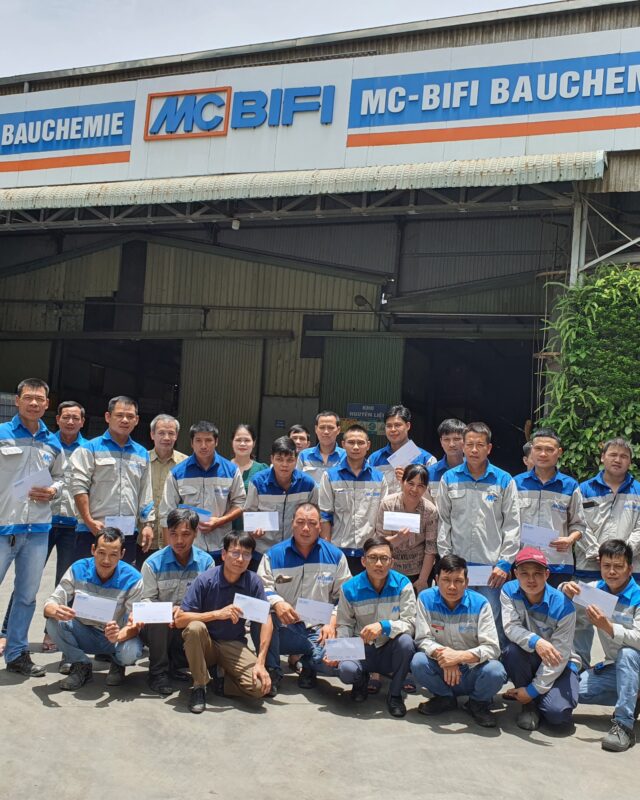By using a variety of admixtures, it is possible to produce concrete with exceptionally high strength, solid strength, waterproofing ability, and high ductility.
Concrete admixtures are compounds or mixtures of inorganic and organic substances of natural or synthetic origin that, when added in small amounts to the concrete mix, will change the technological properties of the concrete, or the intended use of the hardened concrete; Increase the fluidity of the concrete mix, reduce the amount of water and cement used, adjust the setting and setting time, and improve the strength and waterproofing properties of the concrete.
Uses of some additives:
1. Additives to reduce water:
– Water-reducing additives allow water to be reduced during mixing for the same pourability, or increased pourability;
– Water-reducing additives are always organic products that have the ability to reduce tension on the surface or in between the surfaces of the liquid of its own water, they lubricate the cement particles, and the cement particles will separate. together, the dispersion facilitates wetting or hydration.
When adding water-reducing admixtures to the concrete mix, the molecules in the admixture dissolve into the solution, adsorbing on the surface of the solid phases (cement particles, sand, and stone, and the hydration products of cement) and reducing surface tension, separating between solid and liquid phases, and reducing the water film’s thickness surrounding the solid phase.
– When reducing the surface tension of water, the surfactant molecules in the admixture often increase the amount of air entrainment in the concrete mixture during mixing, the amount of air entrainment in the concrete mix also has an effect. increase slump. Air bubbles entrained into the concrete mix are evenly distributed, small in size, acting as buffers on which the solid phases slide over each other more easily, usually 1% increase in air entrainment can be reduced proportionally. 1% of the mixing water.
2. Additive to prolong setting time:
An admixture that, when added to the concrete mix, prolongs the setting time of the concrete mix. Their effects can manifest in different degrees, depending on the properties of the cement, and the dosages used, in general, hardeners decrease in intensity at all initial days and reduce the heat of hydration respectively. Note that when overdosing is used, there is a risk of significantly slowing down the setting time, which may not be directly proportional to the amount of additive added.
The setting extender is used in the following cases:
– Construction in hot weather;
– Transporting concrete long distances;
– Ready-mixed concrete;
– Pumped concrete;
– Sprayed concrete;
– Thin concrete slabs to avoid exposing aggregates after pouring;
– Extrusion construction.
3. Superplasticizer additive:
It is an admixture that can reduce the amount of water while mixing the concrete mixture greatly, but it is different from the normal water-reducing admixture in that it does not affect the setting time of the concrete, so it can create concrete types with high flexibility. In the early stages of superplasticizer development, the effect of the admixture lasted only 30 minutes, so it is necessary to closely monitor the time when the admixture is mixed into the concrete.
Superplasticizers are commonly used for the following purposes:
– Increases the flexibility of the concrete mix while keeping the N/X ratio fixed;
– Increases the strength of concrete by reducing the amount of water
In the range of increasing the mobility of concrete can make concrete 200mm drop. This type of concrete can be self-contained but not self-compacting, the typical field of application of superplasticizers for concrete in the following cases:
– Improve concrete pouring and concrete in areas where concrete components are densely reinforced and difficult to access;
– Producing high-strength concrete;
– Helps to pump concrete farther and higher.
When using superplasticizers, pay attention to the following points:
– Select the appropriate grade for a given cement according to the manufacturer’s instructions and in dosage according to specific conditions;
– Although concrete with superplasticizer can be self-leveling, it must still be compacted tightly;
– Attention must be paid to making the formwork tight so that the concrete does not leak out due to its high mobility. In the case of using superplasticizers with the effect of prolonging the setting time from 2 to 3 hours compared to using no additives, it is allowed to mix more additives at the mixing station.
4. Quick setting additive:
As an admixture that, when added to the concrete mix, has the effect of shortening the setting time of concrete; used to assist in the pouring of concrete in cold weather, allowing concrete to be completed and early removal of formwork possible; this admixture can now be used in condition to seal leaks caused by water pressure, ending the structural repair earlier.
– The effect of this admixture increases the setting process and increases concrete strength in the initial time but can reduce the long-term strength of concrete.
– If used in excess, the concrete will reduce its bearing strength.
5. Waterproofing additives:
As an additive to reduce the level of transmission of moisture released in liquid or vapor form from the tank or through the concrete. Waterproofing admixtures may be in powder, slurry, or liquid form and may contain pore-filling or hydrophobic materials.
Waterproofing additives are used for:
– All applications requiring waterproofing of concrete such as walls and floors, tanks, plumbing, and underground tunnels;
– Concrete blocks and bricks;
– Panels and cement-poor plasters;







